#robert urquhart
Text
I just finished watching The Curse of Frankenstein (1957) and I greatly enjoyed it! Peter Cushing was a delight as Baron Victor Frankenstein! The rest of the cast were very good as well! The one part that I didn’t understand fully (and dislike) is at the end, Paul Kempe doesn’t tell the priest nor the police that he did see the Creature, he shot the Creature and helped Victor bury him, and had even tried to stop Victor for a while by no longer helping him and so he lets everyone think it was solely Victor who was at fault for everything (I mean he was for the most part, but Paul did help him initially with creating life in something dead with the earlier scene of the dog they resurrected)!!! Why did Paul do that?! Victor was begging Paul to tell them what he saw and Paul didn’t!
Also, damn Peter Cushing looks so fine as Baron Frankenstein!😍





#the curse of frankenstein#baron victor frankenstein#paul kempe#peter cushing#robert urquhart#hammer horror#hammer films
17 notes
·
View notes
Photo










The Curse of Frankenstein | Terence Fisher | 1957
#Terence Fisher#The Curse of Frankenstein#1957#Peter Cushing#Robert Urquhart#Valerie Gaunt#Hazel Court#Christopher Lee
49 notes
·
View notes
Text






Man in a Suitcase: Day of Execution (1.3, ITC, 1967)
"I feel awful, just awful, leaving you like this."
"Ah, don't feel bad, it's... it's my business."
"Yeah, I know, but -"
"But what?"
"What're you gonna do?"
"I'm doing it."
#man in a suitcase#day of execution#itc#1967#classic tv#charles crichton#phillip broadley#richard bradford#rosemary nicols#robert urquhart#t. p. mckenna#donald sutherland#jeremy spenser#maggie wright#brian peck#jimmy gardner#sally geeson#brenda lawrence#a personal favourite from childhood watchings and an ep that still stands up very well i think as one of the best MiaS instalments (and has#some very specific mariocki origin lore i won't spoil). has a lot going for it; aside from the strong cast (Sutherland of course but also#Nicols and Urquhart‚ both fresh from starring roles in tv shows Undermind and Jango respectively‚ plus the ever excellent tp mckenna) and a#fairly impressive car chase through nighttime london (good enough the footage was reused in The Saint and Randall and Hopkirk)‚ but we also#get a script that really starts to reckon with McGill's character‚ his past and his personality. a few firsts for the series in this order#inc McGill owning a gun (not carried but kept in his suitcase) renting an apartment and having a love interest; we also learn he went to#college in texas‚ worked in Beirut with US intelligence and has killed (in fact‚ has seen enough violence that he simply doesn't recall the#specific killing that he's being targeted for until it's spelled out for him). it's a darker and brutal episode which hammers home the#moral ambiguity of McGill's character; similarly a moment towards the end of the episode‚ in which he basically threatens to leave Willard#to fend for himself against armed killers unless he pays him a hefty fee‚ is uncharacteristically mercenary for an ITC 'hero'.#Crichton's direction also makes this quite a special episode; he goes heavy on dutch angles and extreme close ups to really push the#ticking clock element and ramp up the pressure‚ with Bradford underplaying the panic just enough to fit the inscrutable McGill image
6 notes
·
View notes
Photo
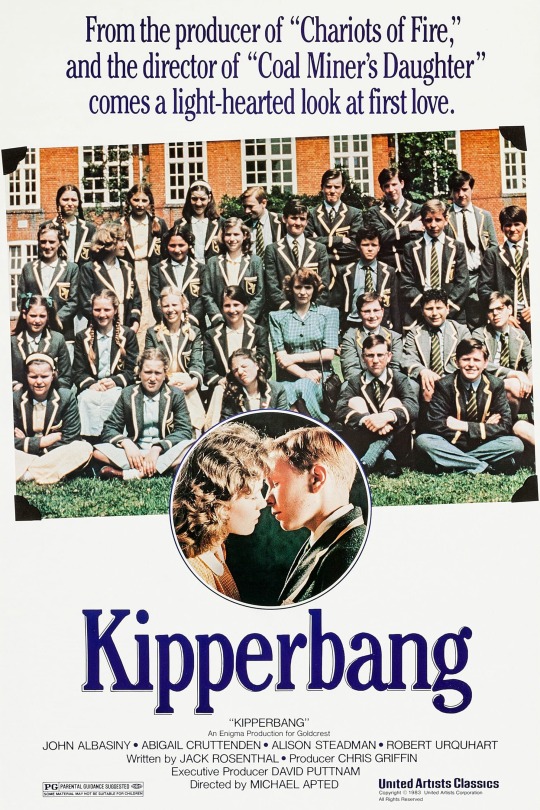
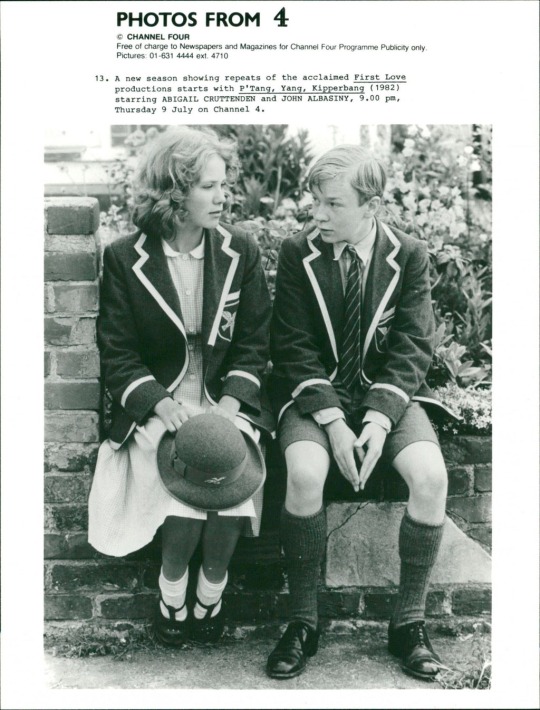
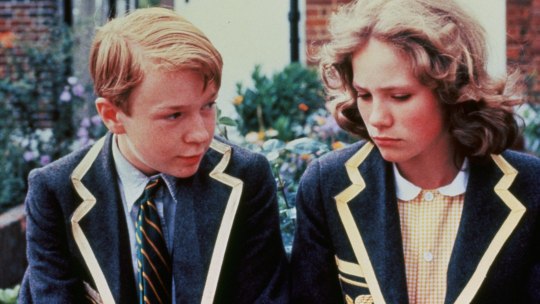
P’tang, Yang, Kipperbang (1982) Michael Apted
August 20th 2022
#p'tang yang kipperbang#1982#michael apted#john albasiny#abigail cruttenden#alison steadman#mark brailsford#christopher karallis#garry cooper#maurice dee#robert urquhart#frances ruffelle#john arlott#first love: p'tang yang kipperbang#kipperbang
7 notes
·
View notes
Text
"VANITY FAIR" (1987) Review
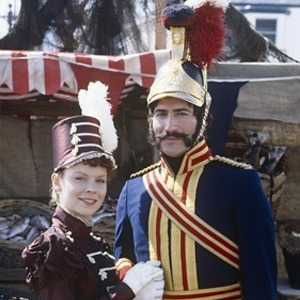
"VANITY FAIR" (1987) Review
I found myself wondering how many adaptations of William Makepeace Thackeray's 1847-1848 novel there have been. As it turned out, this is one piece of literature that has been adapted countless number of times - in film, radio and television. I have seen at least five adaptations myself. And one of them turned out to be the sixteen-part television miniseries that aired on the BBC in 1987.
Since Thackeray's novel is a very familiar tale, I will give a brief recount. Adapted by Alexander Baron and directed by Michael Owen Morris, "VANITY FAIR" told the story of one Rebecca "Becky" Sharp, an impoverished daughter of an English art teacher and French dancer in late Georgian Britain. Determined to climb her way out of poverty and into society, Becky manages to befriend Amelia Sedley, the daughter of a wealthy London merchant. When both finally graduate from Miss Pinkerton's School for Girls, Becky is invited to spend some time with Amelia's family, before she has to assume duties as a governess to the daughters of a minor baronet and landowner named Sir Pitt Crawley. During her time with the Sedleys, she almost manages to snare Amelia's older brother, Jos, a "nabob" from India, as a husband. But the interference of George Osborne, the son of another merchant who happens to Amelia's heart desire, leaves Becky single and employment as a governess. However, upon her arrival at Queen's Crawley, the Crawleys' estate, Becky's charm and wiles inflict a shake-up with the family that would influence lives for years to come.
While viewing "VANITY FAIR", it occurred to me that it is really a product of its time. Although not completely faithful to Thackeray's novel, it struck me as being more so than any adaptation I have seen. Most literary adaptations on television tend to be rather faithful - at least between the 1970s and the 1990s. Especially during the decade of the 1980s. Another sign of this miniseries being a product of its age is the quality of its photography. It is rather faded - typical of many such productions during the 1970s and 1980s. But for me, complete faithfulness to a literary source is not a true sign of the quality of a television adaptation. Nor the quality of the film it was shot on. So, how do I feel about "VANITY FAIR"?
Remember the miniseries' faded look I had commented upon? I really wish it had been shot on better film stock. Stuart Murdoch and Mickey Edwards' visual effects struck me as too eye-catching to be wasted on film stock that quickly faded with time. Another problem I had proved to be the episode that centered around the Battle of Waterloo. I realize that it would make sense for the most of episode's narrative to be told from Becky Sharp Crawley's point of view. Yet, considering that it was able to feature the discovery of one dead character on the battlefield, I wish the episode had been willing to embellish the sequence a bit more. The sequence featured a great deal on Becky and Amelia saying good-bye to their respective spouses, along with Becky bargaining with Jos Sedley over her husband's horses. Overall, the entire sequence . . . nearly the entire episode seemed to lack a sense of urgency over the entire Waterloo campaign and how it affected the main characters. I have one last complaint about "VANITY FAIR" . . . namely the Maquis of Steyne. To be honest, my complaint against him is rather minor. I have a complaint against his physical appearance. Thanks to Lesley Weaver's makeup, I could barely make out actor John Shrapnel's features. He seemed to be a whole mass of hair and whiskers plastered on a slightly reddish countenance.
On the other hand, I really enjoyed how the production went into full detail of Thackeray's novel. Was it completely faithful? I rather doubt it. I noticed how Alexander Baron's screenplay did not adhere to Thackeray's rather nasty portrayal of non-white characters such as Miss Schwartz. Thankfully. On the other hand, Baron, along with director Michael Owen Morris did an excellent job in their portrayals of the novel's main characters - especially Rebecca Sharp, Rawdon Crawley, Amelia Sedley, Jos Sedley, George Osborne, Mr. Osborne and William Dobbin. I will be honest. My favorite segments of the production . . . are basically my favorite segments of the novel. I enjoyed the production's re-creation of Becky's story that began with her departure from Miss Pinkerton's School for Girls to hers and Amelia's adventures during the Waterloo campaign.
Despite the miniseries' limited photography, I must admit there are other aspects of "VANITY FAIR" that impressed me. I enjoyed Gavin Davies and Sally Engelbach's production designs. Both did an admirable of re-creating the production's setting of early 19th century Britain, Belgium, France and Germany. They were ably assisted by set decorations created by the art department, led by David Ackrill and Tony Fisher. But I really must commend Joyce Hawkins' costume designs. I found them colorful and tailor-made. I also thought Ms. Hawkins did an excellent job in her re-creation of the early 19th century fashions.
There is one segment in Thackeray's story I found difficult to enjoy - namely Becky's rise in British society, her relationship with the Maquis of Steyne, the exposure of her as a cold parent and ending with the destruction of her marriage to Rawdon. It is not the fault of Baron, Morris or Thackeray. It is simply my least favorite part of the story. During this segment, Becky transformed from a morally questionable anti-heroine to an outright villainess. Perhaps this is why I found it difficult to revel in Becky's eventual fall. One, I found this portrayal of Becky a bit too one-dimensional for my tastes. Two, there seemed to be this underlying theme in Becky's downfall that she deserved it for being too ambitious, not knowing her place and not being the ideal woman. I realize that I should sweep these feelings away in the wake of her last crime. But for some reason, I cannot. A part of me wonders, to this day, if Thackeray had went too far in this transformation of Becky's character.
I did not have a problem with the performances featured in "VANITY FAIR". If I must be honest, I found them to be very competent. Morris handled his cast very well. The miniseries featured solid performances from Fiona Walker, Shaughan Seymour, Gillian Raine, Tony Doyle, Malcolm Terris, Vicky Licorish, Eileen Colgan, Irene MacDougall, Alan Surtees, and David Horovitch. I also enjoyed the performances from the likes of Freddie Jones, who made a very lively Sir Pitt Crawley; John Shrapnel, who gave an intimidating portrayal of the Maquis of Steyne, underneath the makeup and wig; Siân Phillips, who struck me as a very entertaining Matilda Crawley; David Swift, whose portrayal of Mr. Sedley seemed to reek with pathos; and Philippa Urquhart, who was excellent as the malleable Mrs. Briggs.
But there were those performances that truly impressed me. Robert Lang gave an excellent performance as the ruthless and ambitious Mr. Osborne, who seemed to be handicapped by his own stubborness. Benedict Taylor did a superb job in portraying the varied nature of George Osborne - his charm, his shallowness and selfish streak. James Saxon was equally impressive as the insecure, yet vain Joseph "Jos" Sedley. Simon Dormandy gave a very complex and skillful performance as the priggish William Dobbin, a character I have always harbored mixed feelings about. I personally think that Jack Klaff made the best on-screen Rawdon Crawley I have seen on-screen, so far. Although his character has always been described as an affable, yet empty-headed man who eventually realized he had married a woman beyond his depth. Klaff did an excellent job of conveying those traits more than actor I have seen in the role.
Rebecca Saire seemed perfectly cast as the demure, yet shallow Amelia Sedley, who spent years infatuated with a man she never really knew or understood. It is not often I find an actress who does an excellent of portraying a girl in a woman's body, who at the end, is forced to grow up due to an unpleasant realization. If Saire seemed perfectly cast as the childish Amelia, Eve Matheson struck me as even more perfect as the charming and manipulative Rebecca Sharp. Unlike other actresses who have portrayed Becky, I would never describe Matheson as a beauty, despite being physically attractive. What I found impressive about Matheson's performance is the manner in which she conveyed Becky's ability to charm and seduce others, utilizing her eyes, mannerisms, the ability to cry on cue and her voice. Matheson managed to portray Becky as the most desirable woman around.
I have never seen another on screen Becky Sharp who managed to ooze charm and seduction the way Matheson did. And yet, she also managed to convey Becky's unpleasant side without being theatrical about it. Someone had once described Matheson's Beck as "spunky". Oh please. Spunky? The 1987 Rebecca Sharp was a lot more than that, thanks to Matheson's performance. Dammit, the woman should have received some kind of award for her performance. She was that good.
I have a few quibbles about "VANITY FAIR". Basically, I wish the miniseries had been shot on better film stock. And I wish that the Waterloo sequence had been a bit more . . . embellished. Otherwise, I feel that this 1987 adaptation of William Makepeace Thackeray's novel is the best I have seen so far. I am flabbergasted at how close I came to ignoring this production altogether.

#vanity fair#vanity fair 1987#William Makepeace Thackeray#alexander baron#michael owen morris#waterloo#duchess of richmond's ball#eve matheson#jack klaff#rebecca saire#benedict taylor#fiona walker#david horovitch#freddie jones#john shrapnel#sian phillips#david swift#philippa urquhart#robert lang#james saxon#simon dormandy#malcolm terris#napoleonic wars#period drama#period dramas#costume drama
1 note
·
View note
Text
youtube
Based on the 1882 play by Henrik Ibsen.
Dr. Stockmann, a scientist, goes against popular opinion when he learns that the town's famous "healing springs" are actually poisonous. Not as poisonous, it turns out, as the majority.
0 notes
Text
Evan Urquhart at Assigned Media:
A shakeup at two major news outlets in the US would bodes poorly for Americans interested in factual, responsible coverage of issues relating to the trans community in the mainstream press. Two British men associated with anti-trans culture war publications will take top jobs in US media, according to news reports.
In a hurried announcement memo that went out to Washington Post staff on June 2, publisher William Lewis announced that Robert Winnett of the conservative Daily Telegraph/Sunday Telegraph newspaper would take over leadership of the Washington Post’s core newsroom after the election, following the abrupt resignation of Suzy Buzbee, the previous editor-in-chief. Then, on June 4, Daily Beast CEO Ben Sherwood announced the replacement of editor-in-chief Tracy Connor with Hugh Dougherty, formerly of the New York Post.
Anti-trans bias is ubiquitous throughout print journalism in the UK, so the installation of two British editors would be of note regardless of which publications they’d previously helmed. However, in a news environment flooded with false, malicious, and misleading stories demonizing transgender people in the UK, the Telegraph may be second only to the Daily Mail in its obsessive focus on pushing an anti-trans culture war. Already, on Wednesday morning, the Telegraph has published 10 articles and opinion columns, all negative, relating to the trans community this week.
The New York Post, a right-leaning tabloid, is little better, though its obsession with trans issues has cooled somewhat from a peak last year).
[...]
These sorts of extremely misleading stories have largely been confined to the right-wing press in the United States, except in the case of the New York Times, the one mainstream US newspaper that has repeatedly found creative ways to distort news stories and mislead readers in news reporting relating to gender-affirming care. However, with the installation of Winnett and Dougherty, two outlets whose reporting has remained consistent and objective (though not universally friendly) on trans issues are being helmed by editors connected to two of the worst purveyors of transphobic moral panic in the UK and the US. There’s no sugarcoating it, this does not look good for trans people, or for anyone who believes that journalism should first and foremost be about informing the audience and presenting the truth.
Analogizing to the situation at the New York Times, it has long been surmised that the anti-trans bent the paper took starting roughly in 2022 has been driven by the desire of publisher A. G. Sulzberger, who pressed the NYT to court more readers with right-wing views.
Having right-wing editors-in-chief take charge of the Washington Post and The Daily Beast is a bad omen for trans rights coverage, as both those outlets tend to mostly cover the issue in a respectful way.
#Transgender#Transgender Rights#Transphobia#The Daily Beast#Washington Post#New York Times#The Telegraph#Sunday Telegraph#New York Post#Conservative Media Apparatus#Anti Trans Extremism#Ben Sherwood#Suzy Buzbee#Robert Winnett#Hugh Dougherty#A.G. Sulzberger
15 notes
·
View notes
Text




On April 4th 1617 John Napier, the mathematician, died.
I hated maths with a vengeance at school, I'm not talking about counting, I can hold my own with that, but real maths. algebra, geometry, topology and worst of all logarithms, which we have Robert Napier to "thank" for, he introduced them in the early 17th century as a means to simplify calculations, aye right!
If John Napier had been born a common man he would maybe have been burnt at the stake, nothing to do with him and his maths nonsense but because he dabbled in the occult at a time when we were routinely setting such people on fire!
James VI was on the throne and his obsession with devilry consigned hundreds of unfortunates to the flames. Unless you were born of a noble family of course. A wee bit background on the Napier's his father was Sir Archibald Napier of Merchiston Castle, and his mother was Janet Bothwell, daughter of the politician and judge Francis Bothwell, Lord of Session, and a sister of Adam Bothwell who became the Bishop of Orkney. Archibald Napier was 16 years old when John Napier was born. John, as was the common practice for members of the nobility at that time, he was privately tutored and did not have formal education until he was 13, when he was sent to St Salvator's College, St Andrews. He dropped out of Uni and toured Europe for a time before returning to Scotland aged 21.
Back to his links with sorcery, several members of John Napier’s family – respected and wealthy participants of Edinburgh society - were commonly known to be wizards or sorcerers. Their necromantic power was feared by nobles as well as peasants from far and wide.
The family wizardry started with Napier's father, Sir Archibald, seventh Laird of Merchiston, who successfully predicted when Mary, then the former Queen of Scotland, would leave Lochleven Castle, where she was imprisoned. The story goes: "Claude Nan, the Queen's secretary, wrote that 'the Laird of Markyston (Sir Archibald), who had the reputation of being a great wizard, made bets with several persons to the amount of five hundred crowns, that by the 5th of May Her Majesty would be out of Lochleven." Mary escaped on 2 May 1568 – and the senior Napier was presumably wealthier for his prediction.
Sir Archibald married Janet Bothwell, sister of Adam, Bishop of Orkney, who the paper said was "a notorious necromancer", so that their son, the future mathematician, inherited "a double inclination towards the magic arts". This might explain some of John's odd behaviour. A necromancer is a wizard or magician by the way, I had to google it!
Tenants who lived on the vast Merchiston estate south-west of Edinburgh thought John to be a bit mysterious at times, Napier would be seen many evenings wearing a long gown, pacing outside his tower chamber, a private work area where he often would pass many long hours alone.
Many people thought that his pet black cockerel was a familiar – a supernatural being which assisted witches and wizards in their magical practice. However, the Napier family held the hereditary role of King’s Poulterer and Napier may have kept the cockerel on a whim but I have read he travelled not only with the bird but also with a black spider in a small box, not normal behaviour.
The Scottish writer and translator Sir Thomas Urquhart, who, told of a demonstration of devastating artillery Napier devised against the threat of invasion by Spain.
"He gave proof upon a large plaine in Scotland to the destruction of a great many herds of cattel and flocks of sheep, whereof some were distant from other half a mile on all sides and some a whole mile,"
A well as being a wizard and mathematician Napier was also a fervent Protestant, much of his writing is vehemently anti-Catholic even by the standards of the time. He was a man of contradictions though, as he is said to have had friends who were Catholic, including Alexander Seton, the Earl of Dunfermline, although the vast majority Catholics back then had to hide their faith.
The last interesting, and worrying, fact I found out about John Napier is that his cause of death according to wiki he died "from the effects of gout" at home in Merchiston tower, now I suffer from gout and it is bloody painful but I didn't know it could kill you!
12 notes
·
View notes
Text
Court Circular | 23rd March 2023
Buckingham Palace
His Excellency Mr Yannis Tsaousis was received in audience by The King today and presented the Letters of Recall of his predecessor and his own Letters of Credence as Ambassador from the Hellenic Republic to the Court of St James’s.
His Excellency Mr Koray Ertas was received in audience by The King and presented the Letters of Recall of his predecessor and his own Letters of Credence as Ambassador from the Republic of Turkey to the Court of St James’s.
Mrs Ertas was also received by His Majesty.
Sir Philip Barton (Permanent Under-Secretary of State for Foreign, Commonwealth and Development Affairs) was present.
The King this afternoon officially opened the new London Headquarters of the European Bank for Reconstruction and Development at Five Bank Street, London E14, and was received by Colonel Jane Davis (Vice Lord-Lieutenant of Greater London), the President of the Bank (Mrs Odile Renaud-Basso) and Mr Peter Curwen (the Board Director representing the United Kingdom).
His Majesty toured the Bank, escorted by the President, and met Ukrainian and Turkish staff before viewing an art exhibition of paintings from Ukraine and joining a Meeting with the Board of Directors on green transition.
Mrs Derek Cross was later received by The King upon relinquishing her appointment as The late Queen’s Diary Secretary.
The King was represented by The Duke of Kent at the Service of Thanksgiving for Field Marshal the Lord Inge KG (formerly Chief of the Defence Staff) which was held at St Margaret’s Church, Westminster Abbey, today.
The Queen Consort was represented by General Sir Patrick Sanders.
Kensington Palace
The Prince of Wales today undertook the following engagements in Poland.
His Royal Highness this morning laid a wreath at the Tomb of the Unknown Soldier at Plac Marszalka Józefa Pilsudskiego, Warsaw.
The Prince of Wales afterwards called upon The President of the Republic of Poland at the President’s Chancellery, Warsaw.
His Royal Highness this afternoon met Ukrainian refugees who are settled in the Polish community at Hala Koszyki, Koszykowa 63, Warsaw.
The Prince of Wales subsequently met Ukrainian staff at Hala Koszyki who have been displaced from the British Embassy in Kyiv.
His Royal Highness later arrived at Royal Air Force Northolt from Poland.
Mr Jean-Christophe Gray, Mr Lee Thompson and Commander Robert Dixon RN were in attendance.
St James’s Palace
The Duke of Edinburgh, Patron, The Duke of Edinburgh’s International Award Foundation, this morning chaired a Trustees’ Meeting at 7 More London Riverside, London SE1.
St James’s Palace
The Princess Royal this morning visited Viridor Waste Management’s Dunbar Energy Recovery Facility in Oxwellmains, Dunbar, and was received by His Majesty’s Lord-Lieutenant of East Lothian (Mr Roderick Urquhart).
Her Royal Highness, President, Scotch Chef’s Club, today visited the Monitor Farm Scotland Programme at J. R. B. Wilson and Sons, Cowbog Farm, Morebattle, Kelso, Roxburghshire, and was received by Mr John Jeffery (Deputy Lieutenant of Roxburgh, Ettrick and Lauderdale).
Kensington Palace
The Duchess of Gloucester, Royal Colonel, 7th Battalion The Rifles, this evening attended the Rededication Service of Queen Victoria’s Rifles’ Book of Remembrance at the Parish Church of St. George, Hanover Square, Lodon W1.
#court circular#princess anne#princess royal#king charles iii#prince william prince of wales#prince edward duke of edinburgh#birgitte duchess of gloucester#prince edward duke of kent#british royal family
14 notes
·
View notes
Text
Morgan's timeline
Morgan Rose Urquhart:
-Born in Dover, New Hampshire to Robert and Kathleen Urquhart on January 18, 15 years before the events of the series.
-When Morgan was eight, a clown tried to grab her at a carnival, exacerbating her already-severe coulrophobia*. Her brother Connor, who was ten at the time, saved her and kicked the clown in the shin.
-When Morgan was nine, Connor picked her a flower and said "It’s missing a petal, just like you’re missing a few screws upstairs", yet the flower was beautiful. This event was totally not "borrowed" from a YouTube comment on a Dear Evan Hansen animatic. ;)
-Morgan started playing the clarinet in fourth grade.
-Morgan's family moved to Foxwood when she was ten.
-Morgan befriended Sarah Reinholt in sixth grade.
-Morgan was forced to watch Supersize Me in seventh-grade health class. For almost a year afterwards, she insisted on going by Rose because she was too embarrassed to share a name with Morgan Spurlock. However, Sarah was the only one who remembered to call her that, and even she forgot sometimes.
-Morgan received her iconic Celtic-knot necklace as a thirteenth-birthday gift from Connor. It was the last time she remembered him being nice to her, because it was around the same time that he started pushing her away. She continues to wear the necklace as a symbol of hope for reconciliation with her brother.
-The next year, when she was in eighth grade, Morgan joined the lacrosse team and met Kiera Bernhardt, although they didn't really know each other that well until they were in high school.
-Morgan discovered she was a lesbian at fourteen, when she realized that she had a crush on her best friend Sarah and had never really had any interest in boys.
-In her freshman year of high school, Morgan kicked Nick Murphy in the groin for harassing her brother, and still considers it worth the five-day suspension she received.
-In the summer between her freshman and sophomore years, Morgan got the high score on the Lethal Enforcers machine at the local arcade, which remains unbeaten to this day.
-The next year, Morgan joined the jazz choir, mostly because Sarah suggested that she join.
*Fear of clowns.
2 notes
·
View notes
Photo






The Prime of Miss Jean Brodie - ITV - January 22, 1978 - March 5, 1978
Drama (7 episodes)
Running Time: 60 minutes
Stars
Geraldine McEwan as Jean Brodie
John Castle as Teddy Lloyd
Robert Urquhart as George Jenkins
Lynsey Baxter as Sandy Stranger
Amanda Kirby as Jenny Gray
Vivienne Ross as Miss Campbell
Tracey Childs as Rose Stanley
Georgine Anderson as Miss Gaunt
Madeleine Christie as Mrs. MacDonald
Michael Elder as Rev. Ian Ball
Jean McKinley as Mary MacGregor
George McCormack as Mr. Lawson
3 notes
·
View notes
Text
-_The McGonagalls_-

Elizabeth Loset - Jinx / Kitten - Daughter of Minerva McGonagall and Elphinstone Urquhart

Adrian Lars - Son of Minerva McGonagall and Elphinstone Urquhart

Elphinstone Urquhart - Husband of Minerva McGonagall

Minerva McGonagall - Wife of Elphinstone Urquhart

Robert McGonagall Jr - Brother of Minerva McGonagall

Bernadette McGonagall - Berny - Wife of Robert McGonagall Jr

Vera McGonagall - Daughter of Robert McGonagall Jr and Bernadette McGonagall

Malcom McGonagall - Brother of Minerva McGonagall

Amelia McGonagall - Daughter of Malcom McGonagall and Florence McGonagall (deceased)

Harrison McGonagall - Son of Malcom McGonagall and Florence McGonagall (deceased)
0 notes
Photo

The Curse of Frankenstein | Terence Fisher | 1957
Peter Cushing, Robert Urquhart
22 notes
·
View notes
Text




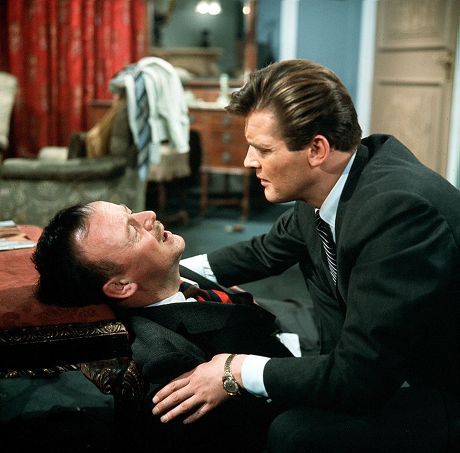


The Saint: The Abductors (4.2, ITC, 1965)
"Inspector Quercy don't be a complete idiot, you know I'm not a murderer."
"I do not suggest that you kill these people."
"Thank you."
"But I do suggest that you are directly responsible for their deaths."
#the saint#the abductors#1965#itc#leslie charteris#brian degas#jeremy summers#roger moore#dudley foster#robert urquhart#annette andre#jennifer jayne#robert cawdron#john serret#nicholas courtney#ronald ibbs#sandor elès#david garfield#martin wyldeck#anthony chinn#unremarkable of plot but strong of cast; this is a fun little episode of international spies and cunning killers. we're in Paris‚ which#means Cawdron makes his 4th appearance as Sgt Luduc‚ as ever accompanied by Insp Quercy (John Serret having replaced Manning Wilson; Serret#had previously played a French Canadian detective in 2.3). Bob Urquhart does his best washed up waster with a heart of gold‚ and the#baddies include baby Nick Courtney as a wicked frenchman and Dudley Foster as... well. immediately i found myself wondering what on earth#he was doing with his voice when‚ horror of horrors‚ another character makes passing reference to his being Welsh. oh Dudley. sigh.#Courtney's villain is a big step up from his previous uncredited role in 3.14 and he gets to go real nasty (slapping around both women in#the episode). Chinn rather unfairly goes uncredited despite having both dialogue and an impressive fight scene. and of course lovely#Annette Andre plays a charmingly eager holidaymaker who gets caught up in Simon's adventure of the week and loves every second of it#oh!! and beautiful Sandor Elés! he'd not long made Evil of Frankenstein but hasn't much to do here (but does it with style and grace and..)#dreamy sigh
5 notes
·
View notes
Text
SPANKING ON TV #2
P’tang, Yang, Kipperbang (1982) d. Michael Apted

A classic touching-toes, three-stroke caning in the Head’s study for 14-year-old Duckworth after “being persistently late three times”.
The film is set shortly after the end of World War 2. Duckworth is a socially awkward lad who’s obsessed with cricket and a girl in his class called Ann. He daydreams his life is narrated by cricket commentator John Arnott. He sees a golden opportunity when he and Ann are cast in the school play together and realises they have to kiss in the final scene.








Publicity stills:


This is a charming, coming-of-age drama with some funny scenes about the daft things teen boys get up to. It’s got a good cast, including an early film role for Alison Steadman. Pete Beale’s in it, and that sergeant bloke off The Bill! It was broadcast in the UK as part of Channel 4’s launch night in 1982 and I remember watching it live with my dad.
The traditional bending-over position is a simple but effective means for a boy to present his backside for caning. The enduring “touching toes” description is a misnomer really, as most boys would grasp their knees or ankles. Speaking from experience, the former is better in terms of maintaining stability!
Amusingly the Head is a bit of a perfectionist and keeps changing canes between strokes, so each one ends up being more painful than the last. Poor Duckworth thinks he’s got away with two but must stay in position for a third, which ends up being a real stinger. The first stroke is shown but it’s audio only/reaction shots for the other two with a very funny commentary from John Arnott.
The message to report to the Head’s study is delivered during a PE lesson, which is why Duckworth is wearing his gym kit. There’s a funny exchange with the PE teacher when he’s told to get going and he says, “But, sir, I’ll need my pants.” For non-British readers, boys weren’t allowed to wear underwear during physical education for reasons such as hygiene or having to sit in wet/muddy pants for the rest of the day, a practice that seems to have persisted well into the 1980s. (Stay tuned for a funny story about this.) Anyway, school shorts of the time were typically thick flannel and lined, so you have to wonder whether writer Jack Rosenthal meant the wily Head had timed Duckworth’s visit for when he’d only be wearing cotton shorts.
John Albasiny was 15 years old when he filmed this and is still acting today. Robert Urquhart, who played the Head, died in 1995.
Here’s the link to the film on YouTube. Fast forward 12 mins to see the Head in action.
youtube
14 notes
·
View notes
Photo
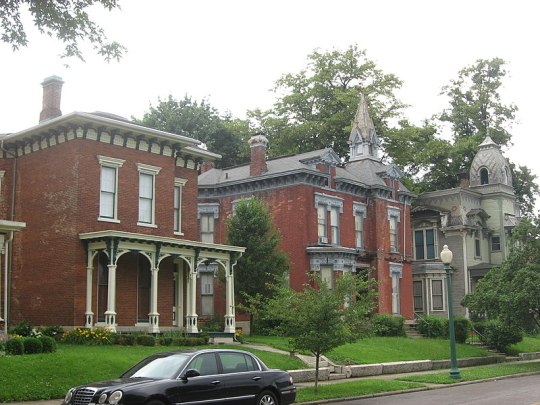



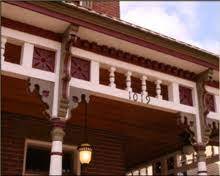
South Fountain Avenue Historic District
S. Fountain Ave.
Springfield, OH
The South Fountain Avenue Historic District is a residential neighborhood in Springfield, Ohio, that covers roughly Fountain Ave. and Limestone St. from Perrin to Monroe Sts. and is listed in the National Register of Historic Places. Developed from the 1850s to the 1920s, concurrent with a period of tremendous growth in the greater community, the South Fountain Avenue Historic District encompasses an area of approximately fifteen square blocks immediately south of downtown Springfield, Ohio across the street from South High School (Springfield, Ohio). Prominent Americans like Oliver S. Kelly, William N. Whiteley, and Francis Bookwalter are counted among the district's founding residents. With the continued success of Whiteley's Champion Reaper and other district owned businesses, South Fountain came to be recognized as a premier residential area for Springfield's affluent.
The South Fountain Historic District is significant as the largest, intact concentration of high-style late 19th and early 20th century houses in Springfield and as the embodiment of the growth of the upper middle class and the prosperity of the industrial and business leaders who populated the neighborhood. Their economic success, during a period of intense industrial growth in Springfield, is reflected in the many distinctive residences in the area. Included are excellent examples of the transitional Greek Revival-Italianate, Gothic Revival, Italianate, Second Empire, Eastlake porches, Queen Anne, Colonial Revival, along with a number of more typical turn of the century housing. Several handsome churches, small commercial buildings and a fire station are the only non-residential buildings which are original to the area.
A number of important business and industry leaders lived along South Fountain--especially those associated with two of the earliest and most successful early industries, the James Leffel Co. and Whiteley, Fassler and Kelly (later became the Champion Co.) Warren Leffel, son of the founder lived at 704. Francis Bookwalter, Vice-President and Treasurer lived at 611. Amos Whiteley, a founder lived at 509, William N. Whiteley at 1103, Oliver S. Kelly, a founder lived at 403, his son Oliver W. Kelly lived at 621. Robert Johnson, Secretary lived at 429. Other important residents included Andrew Black, a dry goods merchant who built Black's Opera House (353 S. Fountain), William D. Bayley, owner of the William Bayley Co. (521 S. Fountain), James Johnson Jr., leading attorney and mayor in 1895 (563 S. Fountain), Hector Urquhart, owner and president of the Springfield Baking Co. (1025 S. Fountain), and Edward W. Simpson, Fire Chief from 1885–1904 and owner of Simpson Lumber Co. (705 S. Fountain).
South Fountain Preservation, Inc. is the neighborhood association in the South Fountain Avenue Historic District and a registered 501(c)3 not-for-profit corporation. The idea behind South Fountain Preservation emerged from hours of discussion over a kitchen table during the summer of 1976. In the fall of that year, the group was founded and began holding regular monthly meetings. Mailings were sent to property owners encouraging them to attend and air their opinions. South Fountain Preservation was chartered as a non-profit corporation in the summer of 1977. The fifteen-member board of directors was chosen and officers were elected. The district was added to the National Register of Historic Places on December 29, 1983.
0 notes